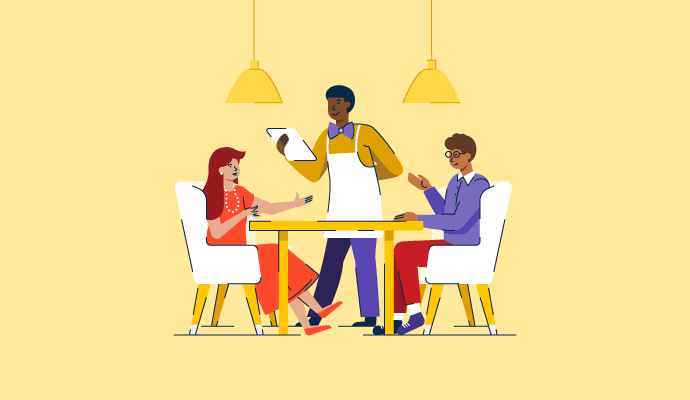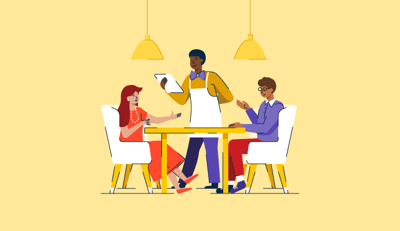March 8, 2024
 by Holly Landis / March 8, 2024
by Holly Landis / March 8, 2024

As a consumer, you’ve been on the receiving end of a point of sale (POS) system thousands of times, but what do you do now that it’s your business? You’re just giving yourself more work to do if you stick to traditional pen-and-paper recording.
Since you’re new to the restaurant industry, or maybe brick-and-mortar businesses in general, you may not be that familiar with everything that a POS can do for you.
Of course, having the right technology is simply one part of the bigger puzzle that comes with opening and running a restaurant. But if you get your POS decision correct from the start, you set your restaurant up to be a great experience for all of your guests and staff.
A restaurant POS system is the main piece of technology that facilitates transactions between diners and businesses. In retail stores, this is usually just the register and payment system. But for restaurants, team members use POS systems to clock in and out, send orders to the kitchen and bar, assign tables, and take payment.
Restaurant POS systems are specifically designed for the food and beverage industry with technology that goes far beyond exchanging money. The best restaurant POS systems help modern restaurants and bars manage their back of house (BOH) and front of house (FOH) operations and improve the overall experience for customers.
Since there are several steps between taking a customer’s order and receiving payment, various types of POS systems help in different ways. They’re typically broken down into two categories.
Not every restaurant requires the same components to make up their complete POS system, but various options available can simplify ordering and payment, employee management, and inventory needs.
Terminals are usually kept behind the bar or at an employee station, but mobile devices, like tablets, are getting popular. Servers use both kinds to take orders digitally. The orders are then sent back to the kitchen system, alerting the cooks to a new ticket. Customers can also pay via card or smartphone wallet from their table’s device.
A tablet or display screen connected to the POS terminals are often considered the command hub for the BOH. As orders come through, they show up on screen for the line cooks to begin their work. Once an order is ready to go out to the customer, some POS systems can alert servers or food runners.
For teams that still prefer to use paper order systems, the kitchen printers can be connected to the POS terminals at the FOH to send order information through. Customers may also want a printed copy of their receipts.
At the most basic level, restaurant POS systems aim to make the process from ordering to end payment as easy as possible.
The process follows similar steps in most restaurants.
Many restaurant POS systems now support additional operational needs, such as:
Best restaurant POS system can quickly become the brain of your operation, allowing you to run and manage everything from a centralized hub.
Some of the key benefits that come from using a restaurant POS system is that it not only makes running your restaurant easier, but can lead to increased profits and happier staff.
Continually collecting data through your POS system means that you base any decisions you need to make on hard facts. Whether you’re considering removing a menu item because it’s not selling well or you want to promote an employee for top sales figures and high tips, the information collected in the restaurant POS system means you can get both high-level and granular insights.
You can manage everything from one system: collecting payments, placing orders, managing schedules, and even adjusting seating plans. This simplifies every employee’s job easier, increasing your team retention rate and overall employee satisfaction.
If you run multiple restaurants, share information from each spot with the others to get a 360°-view of operations. This means that you can continue to grow to new locations as the business sees more success.
Making the general manager and staff’s duties easier is the ultimate goal of a restaurant POS. You should also be looking for a system that’s simple to use for both employees and customers.
To be included in the restaurant POS system category, platforms must:
Below are the top five leading restaurant POS software solutions from G2’s Winter 2024 Grid® Report. Some reviews may be edited for clarity.
Toast is an all-in-one restaurant POS platform that integrates in-person and online ordering through the cloud.
“Toast is a very easy-to-use and modern platform. The staff pick it up very quickly. It generally makes operations pretty smooth. It integrates with other systems very well, so offers great data access.”
- ToastTab Review, Leo C.
“Recently Toast implemented a $.99 service charge, where Toast is charging the restaurant's customers this fee. Please note that restaurants already pay a monthly subscription service fee for the ability to have online ordering.”
- ToastTab Review, Leonard H.
Not exclusively used by the restaurant industry Square is a POS system that offers various payment options and tracks data from a centralized dashboard.
“I like how quick and easy it is to use. It is very organized and makes the categories easy to find and very separated. When customers pay using Square, it is super easy to run a credit card through just as well as cash.”
- Square Review, Marissa P.
“I use my square software everyday for my transportation business. I am on the go most of the time and my clients love the ease of use and how prompt they get their receipts to email or SMS. All around great software and couldn't recommend it enough. Customer support is quick to respond to any kind of questions or concerns.”
- Square Review, Frank C.Z.
Posist is a cloud-based restaurant POS system that unifies front of house, back of house, and operational systems to make running a restaurant more efficient.
“Soft onboarding without any hassle and hundreds of integration available in Posist. Easy to learn and easy to operate. QR ordering feature is the best integration according to us.”
- Posist Review, Rakesh V.
“The system does not provide adequate flexibility to download custom sales reports. Further, most of the reports cannot be downloaded for a period greater than one month.”
- Posist Review, Tarun S.
Clover is designed to replace traditional registers and payment terminals with its integrated suite of tools that optimize restaurant operations.
“Clover is one of the best platforms available to manage cash and take payments without any hustle and writing every time. Using this in my business company actually helps me to work fast and don’t hustle in receiving and transferring payments. The software is totally easy to use. The dashboard is exceptionally well designed and has all the modern-day tools to manage the payments very well.”
- Clover Review, Donna H.
“I can't easily print off multiple transactions. I can download them to a spreadsheet and print off a list, but that has tons of useless info that I have to edit out of the spreadsheet (very time consuming) or I have to screenshot the transaction history (also time consuming) or I have to print them off one by one.”
- Clover Review, Sommer S.
Built for the restaurant industry, Foodics enables restaurants of all sizes to manage their accounting, customer loyalty programs, inventory, and daily operations from one location.
“The system itself has helped us drastically with regard to our operations since it is integrated with our accounting system, ordering platforms, and kitchen station-based display systems (KDS).”
- Foodics Review, Fares A.
“Back end inventory tool needs to be developed considering the transactional constraints.”
- Foodics Review, Jasir A.
Your restaurant POS system should always feel like it’s making your life easier and giving you more time to do what you enjoy most, whether that’s heading back into the kitchen yourself or greeting your guests when they come to dine with you. By choosing a system that suits your specific needs, expect to see more customers coming through your door in no time.
Improve your backend business solutions with restaurant management software that can integrate with your POS system.
Holly Landis is a freelance writer for G2. She also specializes in being a digital marketing consultant, focusing in on-page SEO, copy, and content writing. She works with SMEs and creative businesses that want to be more intentional with their digital strategies and grow organically on channels they own. As a Brit now living in the USA, you'll usually find her drinking copious amounts of tea in her cherished Anne Boleyn mug while watching endless reruns of Parks and Rec.
When I started digging into restaurant POS systems, I didn’t expect to find so many options,...
 by Soundarya Jayaraman
by Soundarya Jayaraman
Running a restaurant involves managing numerous moving parts—staff schedules, inventory,...
.png) by Devyani Mehta
by Devyani Mehta
Manually managing day-to-day inventory, from tracking shipped raw materials to identifying...
 by Dishal Shah
by Dishal Shah
When I started digging into restaurant POS systems, I didn’t expect to find so many options,...
 by Soundarya Jayaraman
by Soundarya Jayaraman
Running a restaurant involves managing numerous moving parts—staff schedules, inventory,...
.png) by Devyani Mehta
by Devyani Mehta


